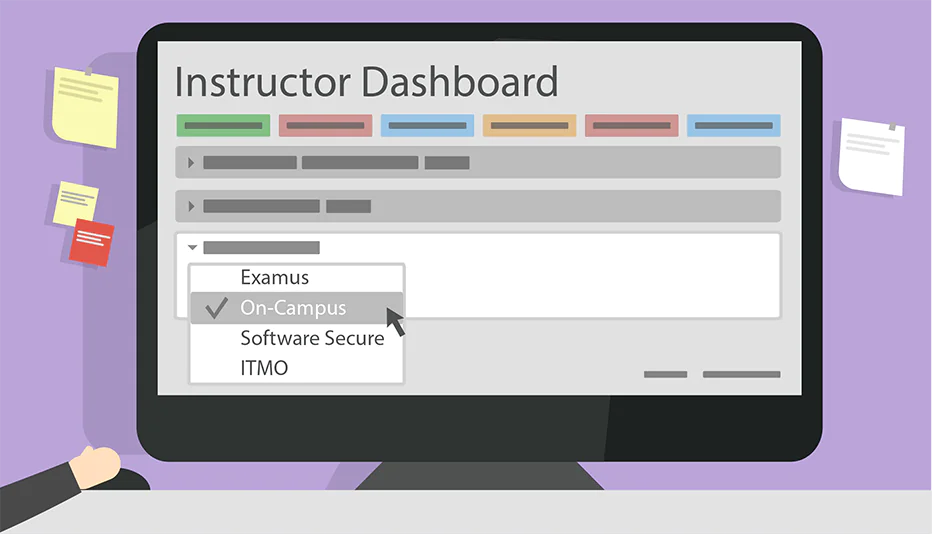We at Raccoon Gang have helped hundreds of customers develop their eLearning programs. Based on our experience, we can easily say that each program is unique. The e-learning modules are created and developed in accordance with the audience’s needs and the specific goals companies have.
To provide you with fresh ideas on how to engage your audience, we’ve compiled some effective eLearning modules you should consider including in your existing and upcoming eLearning applications.
What You Need to Know About eLearning Modules
E-learning modules are a central component of modern digital education. They are designed to be interactive, flexible, and accessible, providing learners with a structured format for their education. eLearning modules are usually self-contained units that focus on a specific topic or skill, which allows learners to progress at their own pace.
These modules can include different kinds of educational content, such as text, images, videos, quizzes, simulations, games, and interactive activities. They also often feature progress tracking, feedback systems, and a variety of support resources to assist learners throughout their educational journey.
E-learning Modules Basics
E-learning modules are designed around a learning objective or set of objectives. Each module should clearly outline its aims, the knowledge and skills it intends to impart, and the way in which it will achieve these aims. To engage learners and promote understanding, modules should also incorporate a variety of teaching and learning methods.
These modules can be accessed through a variety of platforms, including Learning Management Systems (LMS), dedicated eLearning platforms, or through web browsers. They can be designed for different devices (desktop, laptop, tablet, mobile), and they are often designed to be used both offline and online, enabling learners to access them wherever they are, whenever they want.
The length of an eLearning module can vary greatly, depending on the topic and the depth of the content. It can range from a few minutes for microlearning modules to several hours for comprehensive courses.
More About eLearning Modules
One key advantage of eLearning modules is their adaptability to different learning styles. They can be designed with multimedia content to cater to auditory, visual, and kinesthetic learners. They can include interactivity, simulations, and real-world scenarios to provide hands-on experiences, or they can use storytelling, scenarios, and gamification to engage learners emotionally and cognitively.
Furthermore, eLearning modules enable personalized learning pathways. Learners can often choose the order in which they engage with the modules and the pace at which they progress, providing an individualized learning experience. Advanced eLearning modules may also use adaptive learning technologies to adjust the content and difficulty level based on the learner’s performance and needs.
Here are the top eLearning modules:
1. Video Lectures
General Information. Video lectures provide an asynchronous learning experience, enabling students to absorb content at their own pace. By blending expert insights with visually engaging presentations, this eLearning module caters to diverse learning preferences and remains a staple in digital education. Sophisticated platforms now integrate lecture capture systems and dynamic media indexing, enabling learners to locate specific topics within videos effortlessly.
Features:
- Crisp video and audio quality to maintain learner focus.
- Rich visual aids, including animations and diagrams, for enhanced comprehension.
- Accessibility features such as subtitles and multilingual transcripts.
- Interactive tools—like embedded quizzes or discussion prompts—to sustain engagement.
Real-Life Example. Platforms like Khan Academy have set the gold standard for video-based eLearning, offering structured lessons in subjects ranging from calculus to art history. Each lecture is concise yet comprehensive, allowing learners to progress confidently.
2. Interactive Quizzes and Assessments
General Information. Quizzes and assessments have evolved beyond simple multiple-choice questions—modern eLearning modules integrate interactivity to create engaging, real-time evaluations. These tools help reinforce learning objectives while providing immediate feedback. Advanced systems also incorporate performance analytics and cognitive assessment frameworks, ensuring targeted skill evaluation.
Features:
- Adaptive questioning adjusts difficulty based on user performance.
- Dynamic question formats (e.g., drag-and-drop, hotspot selection) ensure variety.
- Instant feedback loops to clarify misconceptions instantly.
- Progress analytics dashboards to track achievements and areas for improvement.
Real-Life Example. The Duolingo language platform exemplifies adaptive assessments. It modifies quiz content in real-time, personalizing each learner’s path to mastery while keeping lessons bite-sized and fun.
3. Case Studies
General Information. Case studies immerse learners in realistic, context-driven scenarios that demand critical thinking and practical application of knowledge. These modules are ideal for industries like healthcare, business, and engineering. By combining data-driven storytelling with scenario-based problem-solving, case studies provide a bridge between theoretical concepts and tangible applications.
Features:
- Thought-provoking real-world narratives to inspire analysis.
- Multimedia content—charts, videos, and documents—for comprehensive exploration.
- Group discussion prompts that encourage collaborative learning.
- Outcome-based scenarios to simulate decision-making processes.
Real-Life Example. The Harvard Business School‘s digital case studies are widely used by global professionals. These studies challenge learners to evaluate complex business dilemmas, bridging academic theory with workplace realities.
4. Gamified Learning Modules
General Information. Gamified modules bring game mechanics into eLearning—leveraging rewards, challenges, and narratives to captivate learners. They make education feel less like a chore and more like an adventure. By employing behavioral reinforcement mechanisms and immersive narrative design, these modules ensure sustained motivation.
Features:
- Achievement systems (badges, points, and leaderboards) to motivate users.
- Interactive storylines that adapt based on learner choices.
- Incremental difficulty levels to sustain engagement over time.
- Immediate rewards to reinforce positive behavior.
Real-Life Example. Platforms like Codecademy gamify technical skill development. By awarding points and unlocking levels, they keep learners invested in their journey to coding proficiency.
5. Discussion Forums
General Information. Discussion forums bring a community-driven approach to eLearning. These platforms provide learners with a virtual space to collaborate, debate, and share knowledge—fostering peer-to-peer growth. Incorporating threaded conversation structures and AI moderation tools ensures that discussions remain relevant and productive.
Features:
- Moderated threads to maintain productive discourse.
- Integration with course materials to contextualize conversations.
- Notification systems for real-time updates on active discussions.
- Searchable archives for learners to revisit key discussions.
Real-Life Example. Coursera’s discussion boards are a hallmark of its courses. They enable participants worldwide to engage in meaningful conversations, making learning a collective experience.
6. Virtual Labs
General Information. Virtual labs replicate traditional laboratory environments using advanced simulations, enabling learners to experiment safely and repeatedly without physical constraints. These modules often utilize real-time process simulation and cloud-based laboratory environments, ensuring scalability and accessibility.
Features:
- Realistic equipment models and procedural accuracy.
- Data collection tools for in-depth analysis during experiments.
- Gamified elements to encourage exploration and creativity.
- Accessibility from any device, making STEM fields more inclusive.
Real-Life Example. Labster, a virtual lab pioneer, empowers students to run experiments like DNA sequencing or chemical synthesis in a controlled digital environment.
7. Branching Scenarios
General Information.
Branching scenarios place learners in the driver’s seat, presenting choices that lead to multiple outcomes. This module nurtures decision-making and critical thinking by mimicking real-world complexity. Leveraging decision-tree logic and multi-path narratives, these scenarios replicate high-stakes environments with realistic outcomes.
Features:
- Interactive narratives with decision points that influence outcomes.
- Feedback loops that explain the consequences of choices made.
- Replayability to explore alternative pathways and outcomes.
- Rich multimedia integration for heightened realism.
Real-Life Example. Kognito’s healthcare simulations provide interactive patient conversations. These scenarios allow learners to navigate sensitive situations, enhancing empathy and communication skills.
8. Interactive Tutorials
General Information.
Step-by-step tutorials walk learners through tasks with practical activities. They break big jobs into small, clear steps. On-screen tips and instant feedback make these tutorials great for building skills.
Features:
- Simulated environments where learners can practice real-world skills.
- Clickable and drag-and-drop elements to promote active learning.
- Built-in hints and feedback systems to aid comprehension.
- Multidevice compatibility for on-the-go access.
Real-Life Example. Microsoft’s interactive tutorials for Office 365 teach users essential software skills with engaging, hands-on walkthroughs.
9. Microlearning Modules
General Information. Microlearning delivers focused lessons designed to be completed in minutes. This module is perfect for busy professionals or learners seeking quick knowledge bursts. By incorporating spaced repetition techniques and targeted learning objectives, microlearning ensures maximum retention in minimal time.
Features:
- Mobile-friendly design for seamless, on-the-go use.
- Short, goal-oriented lessons covering specific topics.
- Standalone format that complements larger courses.
- Multimedia content for enhanced engagement.
Real-Life Example. Duolingo’s bite-sized lessons exemplify microlearning in action. Its compact sessions make language acquisition feel achievable, even in a tight schedule.
10. Project-Based Learning
General Information. Project-based learning helps learners use what they know to solve real problems. This hands-on method builds creativity, teamwork, and practical skills. Newer modules add shared project tools and regular check-ins, making the learning more interactive and focused on results.
Features:
- Realistic projects that mimic workplace challenges.
- Opportunities for collaboration with peers and mentors.
- Iterative feedback loops to refine work and understanding.
- Holistic assessments based on completed projects.
Real-Life Example. Google’s Applied Digital Skills curriculum uses project-based modules to teach essential workplace tools, from creating spreadsheets to designing presentations.
Final Word
Training is a significant part of employee growth and business success, which is why L&D places particular emphasis on it. The most talented professionals choose to work for organizations that offer ongoing learning and development opportunities to staff. Businesses have started looking into the latest eLearning modules to develop engaging training solutions for their employees.
After exploring the top eLearning modules discussed above, you should not waste any more time and go ahead with their implementation.
Raccoon Gang can assist you with e-learning module development that incorporates all the trending modules necessary for your individual case. 👉 Click here to obtain a quote.
FAQ
What is an eLearning module?
An eLearning module is a self-contained unit of online training focused on one topic or skill. It can include video, text, quizzes, simulations, and interactive tasks and is usually delivered through an LMS or other eLearning platform.
What are the main types of eLearning modules?
Common eLearning module types include video lectures, interactive quizzes, case studies, gamified learning modules, discussion forums, virtual labs, branching scenarios, interactive tutorials, microlearning modules, and project-based learning. Most effective programs mix several of these formats in one learning path.
How long should an eLearning module be?
Most corporate eLearning modules work best in the 10–20 minute range. Microlearning modules are shorter (3–7 minutes), while project-based or lab-style modules can be longer if they guide learners through a complete task or scenario.
What is the difference between an eLearning module and an online course?
An eLearning module covers a specific topic or skill. An online course combines multiple modules into a structured pathway with goals, assessments, and completion criteria.
Which eLearning modules work best for busy employees?
Short formats such as microlearning modules, interactive tutorials, and quick quizzes usually perform best for busy teams. They fit into workday gaps and can be completed on mobile devices without blocking calendars.
How can Raccoon Gang help with eLearning module development?
Raccoon Gang designs and builds custom eLearning modules—video, microlearning, gamified modules, virtual labs, and more—and integrates them with your LMS. Our team can help with instructional design, technical implementation, and ongoing support so your modules match both business goals and learner needs.






